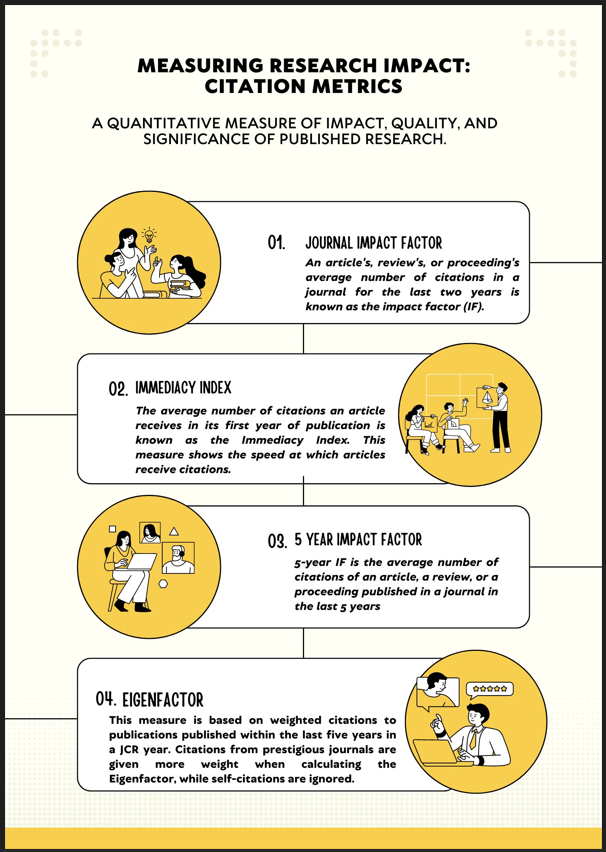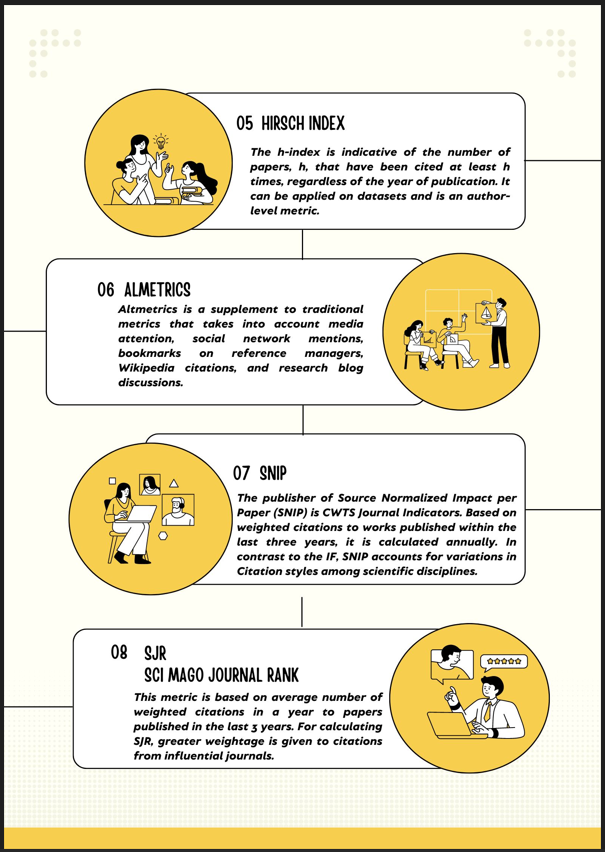CITATION METRICS
Citations are considered the most widely used metric to assess the impact (or lack of impact) of a journal article. Citation metrics are based on the number of times a work is cited. So, the more citations a work has, potentially the more significant the impact of the research.
Citation counts are not comparable across disciplines; for example, citation counts in social sciences and humanities are lower because researchers are more often publishing books and conference papers that need to be better covered by citation databases.
Alternative metrics
Alternative metrics can measure the broader societal impact of the researcher’s published work, e.g., downloads or readings, tweets, reviews, or impact on communities, health, environmental benefits, commercialisation or economic value.
Altimetrics are alternative approaches to measuring the impact of a scholarly work, as demonstrated by users' interest in and engagement with it. Altimetrics track mentions of a work in social media outlets such as Twitter, blog posts, and research networking sites, plus use in newspapers or government policy documents. They include evidence of user activity tracked by publishers and indexing databases, such as PDF downloads, page views, and exports of citations to reference management systems.
Limitations:
Alternative metrics may not represent the quality of the researcher’s work or the author as the researcher;
Always look for qualitative comments as well.
Citation metrics cannot always be a reliable method to judge the article/ works.
Before judging an article based on a citation count or metric, the following limitations of citations as evaluation metrics should be considered:
A citation is not necessarily a positive reference. An article can be highly cited because it is controversial, satirical, or its claims are being challenged. Note that a paper that has been retracted by its publisher can continue to accrue citations.
Review papers tend to be more well-cited than original research papers, and this can deny authors of original concepts and results their deserved credit. Because of this, citations must never be used to compare between articles of different types.
Some studies of citation patterns suggest that gendered and racial biases exist in citation networks. This could mean that citation counts underrepresent the impact of female or Black, Asian and Minority Ethnic authors.
Research is done across the world in all languages, yet the dominant language for research publishing is English. This can exclude non-English language research from being made discoverable and cited by other readers. When an English-language article is cited by a non-English language article or journal, this citation might not be picked up in the citation count.
Some commentators have asked, ‘Do authors cite another paper just because it is already highly cited?’. Whilst not proven, a prestige effect that causes authors to cite a well-known paper over a lesser-known paper is possible.
Why are citation metrics so important?

Cited reference searching is the process of seeking when an article, book, journal, or particular author is cited in another work. Gathering a work's citation impact can help the researcher:
determine the impact of an article, book, journal, or author in the research field
identify suitable journals in which to publish.
monitor the latest research in a particular field.
identify potential research partners.
Citing databases
Article databases often have access to subsequent research that cites paper/s. Look for the links to:
Times Cited, e.g. Web of Science, BIOSIS Citation Index
Cited Reference search in Web of Science
Citing articles, e.g. ScienceDirect
Cited by, e.g. Scopus, Google Scholar, ProQuest
Times Cited in this Database, e.g. Business Source Complete
PlumX Metrics, e.g. Scopus
Altmetrics (at article level), e.g. Scopus, SpringerLink, Taylor & Francis, Wiley Online Library


